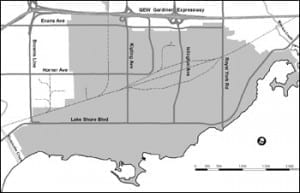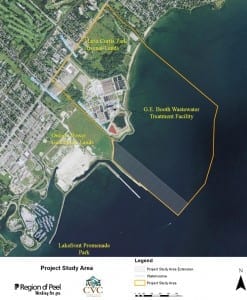Etobicoke waterfront stormwater management facilities study. Lakeview waterfront connection study: Meeting on Jan. 22, 2013.
Etobicoke waterfront
You can find information here regarding the Etobicoke waterfront stormwater facilities project.
Information about the municipal class environmental assessment (EA) study related to this facilities study is available here.
A document related to the study has been placed on record between Jan. 10 and Feb. 11, 2013. If you have any “outstanding issues,” you are directed to address them to City staff listed on the document.
A summary of the Feb. 2, 2012 public meeting regarding this study is available here.
The summary notes that more naturalized solutions were explored and “were determined to be unfeasible.” The document (see link in previous sentence) adds:
“The side of natural facilities would have to be massive and the existing areas are either too small to accommodate a naturalized storm water management wetland or pond, or will have significant adverse impacts on existing terrestrial habitats and existing use of parks.”
Lakeview waterfront
An environmental assessment process involving the Lakeview waterfront connection is now under way in Mississauga. A public meeting will be held on Jan. 22, 2013 at the Mississauga Seniors’ Centre at 1389 Cawthra Road.
It’s always of interest to contrast and compare how different jurisdictions address planning issues related to the Lake Ontario waterfront.
On the left is a map of the Lakeview waterfront connection study area. Click on the image to enlarge it.
A Lakeview waterfront connection document provides information about Mississauga’s waterfront project.
An earlier Lakeview feasibility study explored the merits of re-using locally generated fill to create a waterfront greenspace between Marie Curtis Park in Toronto and Lakefront Promenade Park in Mississauga. It was agreed that a new waterfront greenspace could be designed to serve multiple recreational functions and re-create critical coastal habits including wetlands, forests, and spawning areas.



Leave a Reply
Want to join the discussion?Feel free to contribute!